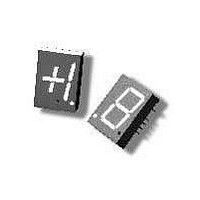HDSP-5538 Avago Technologies US Inc., HDSP-5538 Datasheet - Page 8

HDSP-5538
Manufacturer Part Number
HDSP-5538
Description
DISPLAY 7SEGMENT HER CC 0.56"
Manufacturer
Avago Technologies US Inc.
Type
Moduler
Specifications of HDSP-5538
Display Type
7-Segment
Common Pin
Common Cathode
Number Of Digits/alpha
+/-1 (overflow)
Size / Dimension
0.67" L x 0.49" W x 0.31" H (17.02mm x 12.57mm x 8.00mm)
Digit/alpha Size
0.56" (14.22mm)
Color
Red
Voltage - Forward (vf) Typ
2.6V
Current - Test
20mA
Millicandela Rating
4.8mcd
Wavelength - Peak
635nm
Power Dissipation (max)
105mW
Package / Case
10-DIP (0.600", 15.24mm), 9 Leads
Number Of Digits
1
Character Size
14.1 mm
Illumination Color
High Efficiency Red
Wavelength
635 nm
Operating Voltage
2.6 V
Operating Current
40 mA
Maximum Operating Temperature
+ 85 C
Minimum Operating Temperature
- 40 C
Luminous Intensity
4800 ucd
Package Type
DIP
Product Length (mm)
17.1mm
Product Height (mm)
8mm
Product Depth (mm)
12.4mm
Character Displayed
Numeric
Emitting Color
Hi-Eff. Red
Forward Voltage
3.5V
Forward Current
40mA
Dominant Wave Length
636nm
Power Dissipation
105mW
Total Thickness
8mm
Reverse Voltage
5V
Mounting
Through Hole
Operating Temperature Classification
Industrial
Pin Count
10
Configuration
Common Cathode
Number Of Elements
5
Peak Wavelength
635nm
Reverse Current
100uA
Lead Free Status / RoHS Status
Lead free / RoHS Compliant
Lead Free Status / RoHS Status
Lead free / RoHS Compliant, Lead free / RoHS Compliant
dc current (I
Figure 2 presents the maximum
allowed dc current vs. ambient
temperature. Figure 1 is based on
the principle that the peak junc-
tion temperature for pulsed
operation at a specified peak
current, pulse duration and
refresh rate should be the same
as the junction temperature at
maximum DC operation. Refresh
rates of 1 kHz or faster minimize
the pulsed junction heating effect
of the device resulting in the
maximum possible time average
luminous intensity.
The time average luminous inten-
sity can be calculated knowing
the average forward current and
relative efficiency characteristic,
luminous intensity for a device
case temperature of 25 C, I
(25 C), is calculated as follows:
I
Example: For HDSP-4030 series
For DF = 1/5:
I
The time average luminous inten-
sity may be adjusted for operat-
ing junction temperature by the
following exponential equation:
I
where T
8
V
V
V
|PEAK
|PEAK
(25 C) =
(25 ) =
(T
-4030/-4130/
-553x/-3900
-5730/-4200
J
) = I
Device
, of Figure 3. Time average
= 1.00 at I
= 4.5 mcd/segment
J
[
= T
[
20 mA
V
–––––
20 mA
20 mA
––––––
I
AVG
(25 C) e
PEAK
A
+ P
]
[
]
MAX/I
|PEAK
PEAK
D
[1.00][4.5 mcd]
[k(T
• R
-0.0131/ C
-0.0112/ C
] [I
= 100 mA.
J
DC
V DATA SHEET
+ 25 C)]
J-A
K
MAX).
V
]
Mechanical
These devices are constructed
utilizing a lead frame in a
standard DIP package. The LED
dice are attached directly to the
lead frame. Therefore, the
cathode leads are the direct
thermal and mechanical stress
paths to the LED dice. The
absolute maximum allowed
junction temperature, T
105 C. The maximum power
ratings have been established so
that the worst case V
not exceed this limit.
Worst case thermal resistance
pin-to-ambient is 400 C/W/Seg
when these devices are soldered
into minimum trace width PC
boards. When installed in a PC
board that provides R
than 400 C/W/Seg these displays
may be operated at higher
average currents as shown in
Figure 2.
Optical
The radiation pattern for these
devices is approximately Lam-
bertian. The luminous sterance
may be calculated using one of
the two following formulas.
-553x/-5730
-3900/-4200
L
Device
-4030
-4130
V
(footlamberts) = –––––––
L
V
(cd/m
Area/Seg. Area/Seg.
mm
14.9
2.5
4.4
8.8
2
) = ––––––
2
F
device does
PIN-A
J
I
A(m
A(ft
V
I
MAX, is
(cd)
V
0.0039
0.0068
0.0137
0.0231
(cd)
in
less
2
2
)
)
2
Contrast Enhancement
The objective of contrast enhance-
ment is to optimize display
readability. Adequate contrast
enhancement can be achieved in
indoor applications through
luminous contrast techniques.
Luminous contrast is the
observed brightness of the
illuminated segment compared to
the brightness of the surround.
Appropriate wavelength filters
maximize luminous contrast by
reducing the amount of light
reflected from the area around
the display while transmitting
most of the light emitted by the
segment. These filters are
described further in Application
Note 1015.
Chrominance contrast can further
improve display readability.
Chrominance contrast refers to
the color difference between the
illuminated segment and the
surrounding area. These displays
are assembled with a gray package
and untinted encapsulating epoxy
in the segments to improve
chrominance contrast of the ON
segments. Additional contrast
enhancement in bright ambients
may be achieved by using a
neutral density gray filter such as
Panelgraphic Chromafilter Gray
10, or 3M Light Control Film
(louvered film).




















